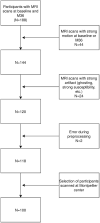Impact of multidomain preventive strategies on functional brain connectivity in older adults with cognitive complaint: Subset from the Montpellier center of the ancillary MAPT-MRI study
- PMID: 36705622
- PMCID: PMC9871772
- DOI: 10.3389/fnagi.2022.971220
Impact of multidomain preventive strategies on functional brain connectivity in older adults with cognitive complaint: Subset from the Montpellier center of the ancillary MAPT-MRI study
Abstract
Introduction: The impact of multi-domain preventive interventions on older adults, in particular on those with higher risk to develop Alzheimer's disease (AD), could be beneficial, as it may delay cognitive decline. However, the precise mechanism of such positive impact is not fully understood and may involve brain reserve and adaptability of brain functional connectivity (FC).
Methods: To determine the effect of multidomain interventions (involving physical activity, cognitive training, nutritional counseling alone or in combination with omega-3 fatty acid supplementation and vs. a placebo) on the brain, longitudinal FC changes were assessed after 36 months of intervention on 100 older adults (above 70 year-old) with subjective cognitive complaints.
Results: No global change in FC was detected after uni or multidomain preventive interventions. However, an effect of omega-3 fatty acid supplementation dependent on cognitive decline status was underlined for frontoparietal, salience, visual and sensorimotor networks FC. These findings were independent of the cortical thickness and vascular burden.
Discussion: These results emphasize the importance of patient stratification, based on risk factors, for preventive interventions.
Keywords: cognitive training; exercise; magnetic resonance imaging (MRI); multidomain intervention; omega-3 fatty acids; resting-state functional MRI (rs-fMRI).
Copyright © 2023 Perus, Mangin, Deverdun, Gutierrez, Gourieux, Fischer, Van Dokkum, Manesco, Busto, Guyonnet, Vellas, Gabelle, Le Bars and the MAPT/DSA group.
Conflict of interest statement
BV reports grants from Pierre Fabre, Avid, Exonhit, AbbVie, Lilly, Lundbeck, MSD, Otsuka, Regenron, Sanofi, Roche, AstraZeneca, LPG Systems, Nestlé, and Alzheon, and personal fees from Lilly, Lundbeck, MSD, Otsuka, Roche, Sanofi, Biogen, Nestlé, Transition Therapeutics, and Takeda. The remaining authors declare that the research was conducted in the absence of any commercial or financial relationships that could be construed as a potential conflict of interest.
Figures


Similar articles
-
MAPT STUDY: A MULTIDOMAIN APPROACH FOR PREVENTING ALZHEIMER'S DISEASE: DESIGN AND BASELINE DATA.J Prev Alzheimers Dis. 2014 Jun;1(1):13-22. J Prev Alzheimers Dis. 2014. PMID: 26594639 Free PMC article.
-
Effect of long-term omega 3 polyunsaturated fatty acid supplementation with or without multidomain intervention on cognitive function in elderly adults with memory complaints (MAPT): a randomised, placebo-controlled trial.Lancet Neurol. 2017 May;16(5):377-389. doi: 10.1016/S1474-4422(17)30040-6. Epub 2017 Mar 27. Lancet Neurol. 2017. PMID: 28359749 Clinical Trial.
-
Commentary on "A roadmap for the prevention of dementia II. Leon Thal Symposium 2008." The Multidomain Alzheimer Preventive Trial (MAPT): a new approach to the prevention of Alzheimer's disease.Alzheimers Dement. 2009 Mar;5(2):114-21. doi: 10.1016/j.jalz.2009.01.008. Alzheimers Dement. 2009. PMID: 19328438 Clinical Trial.
-
Effects of preventive interventions on neuroimaging biomarkers in subjects at-risk to develop Alzheimer's disease: A systematic review.Front Aging Neurosci. 2022 Nov 24;14:1014559. doi: 10.3389/fnagi.2022.1014559. eCollection 2022. Front Aging Neurosci. 2022. PMID: 36506466 Free PMC article.
-
Bilingual experience and intrinsic functional connectivity in adults, aging, and Alzheimer's disease.Ann N Y Acad Sci. 2021 Dec;1505(1):8-22. doi: 10.1111/nyas.14666. Epub 2021 Jul 26. Ann N Y Acad Sci. 2021. PMID: 34309857 Review.
Cited by
-
Mechanisms of interventions targeting modifiable factors for dementia risk reduction.Mol Neurodegener. 2025 Jun 23;20(1):75. doi: 10.1186/s13024-025-00845-w. Mol Neurodegener. 2025. PMID: 40551205 Free PMC article. Review.
References
-
- Andrieu S., Guyonnet S., Coley N., Cantet C., Bonnefoy M., Bordes S., et al. . (2017). Effect of long-term omega 3 polyunsaturated fatty acid supplementation with or without multidomain intervention on cognitive function in elderly adults with memory complaints (MAPT): a randomised, placebo-controlled trial. Lancet Neurol. 16, 377–389. 10.1016/S1474-4422(17)30040-6 - DOI - PubMed
LinkOut - more resources
Full Text Sources

